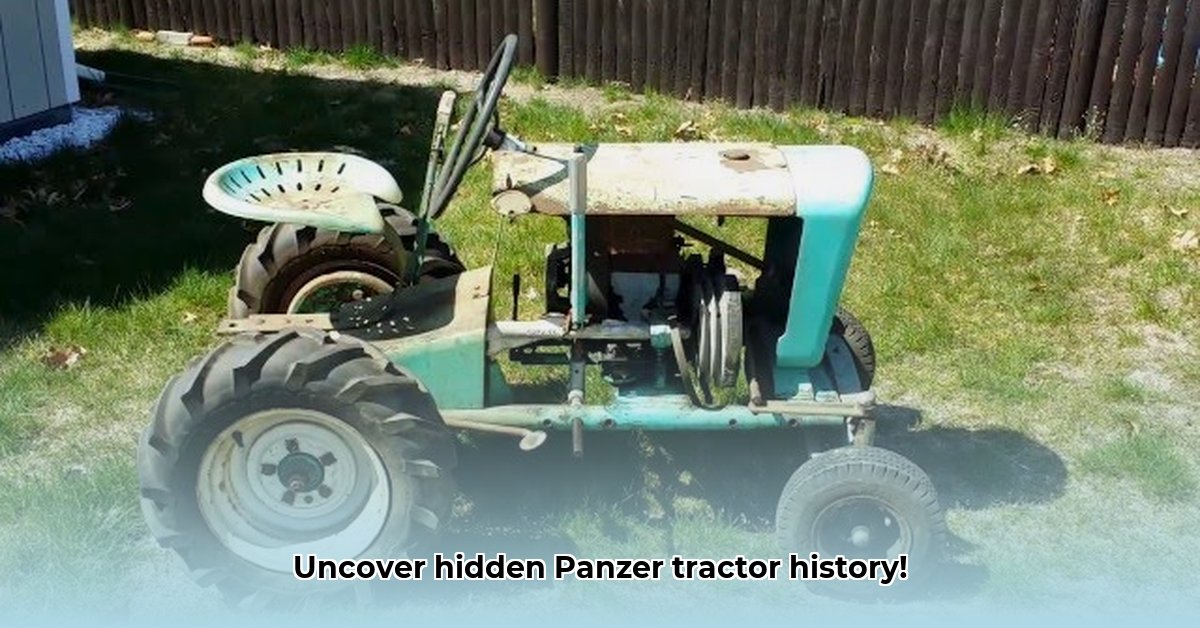
Panzer Lawn Tractor: A Collector's Deep Dive
The Panzer lawn tractor—a quirky piece of American ingenuity—isn't your grandfather's riding mower. Its story, beginning in the mid-1950s, blends clever engineering, surprising business decisions, and a devoted following that endures to this day. This compact tractor's legacy showcases how a simple, well-executed idea can leave a lasting mark. But how did this unusual machine gain such devoted fans? For more on similar vintage tractors, check out this resource on Troy-built tractors.
From Backyard Dream to Small-Yard Wonder
The Panzer's narrative starts in 1953, College Park, Maryland. Imagine James A. Clark, a homeowner likely weary of cumbersome lawnmowers, conceiving a smaller, more agile machine. He didn't just want any tractor; he envisioned something revolutionary. The result? The Panzer, featuring a cutting-edge "Glidamatic" transmission (a smooth, user-friendly system for its time). This made it a game-changer for smaller lawns, offering effortless maneuverability where larger tractors struggled. Wasn't this innovative design a testament to American ingenuity?
A Name Change and a Shifting Landscape
Initially produced by Copar, the Panzer quickly became a favorite among homeowners with compact yards. Its agility and small size were undeniably attractive. However, the agricultural equipment industry is dynamic, marked by mergers and acquisitions. Copar's acquisition by Virginia Metalcrafters led to a rebranding as the Pennsylvania Panzer. This renaming reflects the common story of smaller companies being absorbed by larger corporations – a recurring theme across various industries. What other examples of similar industry shifts can you recall?
More Than Just a Name: The Panzer's Ingenious Design
The Panzer’s enduring appeal wasn't solely due to its name. Its design was brilliantly simple. Many believe resourceful engineers utilized readily available automobile parts, possibly from Dodges or Plymouths—a form of early automotive upcycling! This clever approach, combined with exceptional maneuverability, differentiated it from competitors. Picture effortlessly navigating tight corners or maneuvering around obstacles—a significant advantage over larger tractors. This practicality fostered a loyal following that persists today.
A Legacy of Loyalty: Why the Panzer Still Matters
Although production ended around 1971, the Panzer's story isn't over. Dedicated collectors and enthusiasts keep its memory alive, forming a tight-knit community. The ongoing availability of parts through companies like Dandy Sales Inc. testifies to the Panzer's lasting appeal and robust build quality. It's remarkable for a piece of equipment, especially a lawn tractor, to maintain such dedicated support decades after it was discontinued. Why do you think this level of loyalty persists?
Uncovering the Panzer's Secrets: What We Know (and Don't Know)
While much is known about the Panzer, a complete picture remains elusive. Detailed technical specifications are scarce, with available information often inconsistent. What engine powered each Panzer? This varies; some likely used Briggs & Stratton engines, while others may have used different models. Further research is crucial to solve this puzzle.
| Feature | Specification (Where Available) | Notes |
|---|---|---|
| Transmission | Glidamatic – a key feature of the innovative design | Known for smooth and easy operation |
| Engine | Varied, likely including Briggs & Stratton and possibly others | Specific engine models require further investigation |
| Drive System | Rear-wheel drive | Standard for lawn tractors of that era |
| Construction | Steel | Contributed to the Panzer’s longevity |
Becoming a Panzer Guardian: A Collector's Journey
If you're captivated by the Panzer and wish to contribute to its legacy, several avenues exist. Join online forums dedicated to vintage tractors to connect with others, share knowledge, and potentially locate rare parts. Restoring a Panzer is rewarding but challenging, requiring meticulous research and patience. Attending antique tractor shows provides opportunities to appreciate these machines’ history and network. The goal is to preserve this innovative machine's legacy for future generations.
The Unwritten Chapters: Future Research
Much about the Panzer remains unknown. Key areas for future research include determining the total number of Panzers produced, its market share, and a comparison to its competitors to understand its unique design innovations. Examining safety regulations and manufacturing practices of the era will further contextualize its development. A wealth of untold information awaits discovery.
How to Find Parts for a Vintage Panzer Tractor
Key Takeaways:
- The PanzerTractors.com website is a vital information resource and community hub.
- Suppliers like HAPCO might carry parts, but availability is unpredictable.
- Community engagement is essential for locating hard-to-find components.
- Preserving historical records is crucial for future restoration efforts.
- Alternative sourcing methods, such as 3D printing, may be necessary.
Unearthing Panzer Parts: A Collector's Quest
Finding parts for a Panzer tractor can be challenging. While resources like Allen Lawnmower are no longer available, a dedicated community of Panzer enthusiasts provides support.
PanzerTractors.com: Your Digital Headquarters
Since 1996, PanzerTractors.com has served as a central hub, offering parts lists, repair manuals, and a community forum to connect with fellow enthusiasts. This is your first stop in the search for parts or information.
Beyond the Website: Expanding Your Search
Beyond the website, consider contacting suppliers directly (like HAPCO), exploring online marketplaces (eBay, Craigslist), attending tractor shows, and even checking scrap yards.
Strategies for Success: Turning Challenges into Opportunities
The scarcity of parts prompts creativity. 3D printing and fabrication are viable options for recreating or modifying components.
The Power of Community: Sharing the Journey
The global Panzer tractor community is a network of support, sharing information, parts, and encouragement. Collaboration is key.